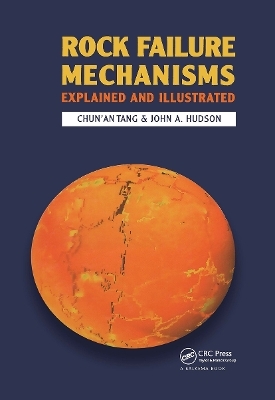
Rock Failure Mechanisms
Illustrated and Explained
Seiten
2024
CRC Press (Verlag)
978-1-032-92109-9 (ISBN)
CRC Press (Verlag)
978-1-032-92109-9 (ISBN)
Illustrated guide on rock failure under a variety of load conditions. For researchers and professionals in geology, mining and civil engineering working with rock failure concepts in the engineering practice. Includes a CD-ROM with a version of RFPA (Rock Failure Process Analysis) software.
When dealing with rock in civil engineering, mining engineering and other engineering, the process by which the rock fails under load should be understood, so that safe structures can be built on and in the rock. However, there are many ways for loading rock and rock can have a variety of idiosyncracies. This reference book provides engineers and researchers with the essential knowledge for a clear understanding of the process of rock failure under different conditions. It contains an introductory chapter explaining the role of rock failure in engineering projects plus a summary of the theories governing rock failure and an explanation of the computer simulation method. It subsquently deals in detail with explaining, simulating and illustrating rock failure in laboratory and field. The concluding chapter discusses coupled modelling and the anticipated future directions for this type of computer simulation. An appendix describing the RFPA numerical model (Rock Failure Process Analysis program) is also included.
About the AuthorsChun'an Tang has a PhD in Mining Engineering and is a Professor at the School of Civil & Hydraulic Engineering at Dalian University of Technology in China. He is an advisor for design and stablity problem modelling in mining and civil rock engineeringand and Chairman of the China National Group of the International Society for Rock Mechanics.
John Hudson is emeritus professor at Imperial College, London and is active as an independant consultant for Rock Engineering Consultants. He has a PhD in Rock Mechanics and completed over a 130 rock engineering consulting assignments in mining and civil engineering. He is a fellow at the Royal Academy of Engineering in the UK and President of the International Society for Rock Mechanics.
When dealing with rock in civil engineering, mining engineering and other engineering, the process by which the rock fails under load should be understood, so that safe structures can be built on and in the rock. However, there are many ways for loading rock and rock can have a variety of idiosyncracies. This reference book provides engineers and researchers with the essential knowledge for a clear understanding of the process of rock failure under different conditions. It contains an introductory chapter explaining the role of rock failure in engineering projects plus a summary of the theories governing rock failure and an explanation of the computer simulation method. It subsquently deals in detail with explaining, simulating and illustrating rock failure in laboratory and field. The concluding chapter discusses coupled modelling and the anticipated future directions for this type of computer simulation. An appendix describing the RFPA numerical model (Rock Failure Process Analysis program) is also included.
About the AuthorsChun'an Tang has a PhD in Mining Engineering and is a Professor at the School of Civil & Hydraulic Engineering at Dalian University of Technology in China. He is an advisor for design and stablity problem modelling in mining and civil rock engineeringand and Chairman of the China National Group of the International Society for Rock Mechanics.
John Hudson is emeritus professor at Imperial College, London and is active as an independant consultant for Rock Engineering Consultants. He has a PhD in Rock Mechanics and completed over a 130 rock engineering consulting assignments in mining and civil engineering. He is a fellow at the Royal Academy of Engineering in the UK and President of the International Society for Rock Mechanics.
1. Introduction; 2. Uniaxial tension; 3. Indirect tension; 4. Uniaxial compression; 5. Confinement and shear; 6. Heterogeneity; 7. Anisotropy; 8. Loading, unloading, Kaiser effect; 9. Time dependance; 10. Coalescence; 11. Dynamic loading; 12. Water flow; 13. Thermal stress; 14. Slope failure; 15. Cutting inhomogeneous rocks; 16. Tunnels in jointed rock; 17. Longwall coal mining; 18. Gas outbursts in coal mines; 19. Particle breakage and comminution; 20. 3-D Modelling and 'turtle crack formation'; 21. Conclusion.
| Erscheinungsdatum | 16.10.2024 |
|---|---|
| Verlagsort | London |
| Sprache | englisch |
| Maße | 174 x 246 mm |
| Gewicht | 671 g |
| Themenwelt | Naturwissenschaften ► Geowissenschaften ► Geologie |
| Technik ► Bauwesen | |
| Technik ► Umwelttechnik / Biotechnologie | |
| ISBN-10 | 1-032-92109-9 / 1032921099 |
| ISBN-13 | 978-1-032-92109-9 / 9781032921099 |
| Zustand | Neuware |
| Haben Sie eine Frage zum Produkt? |
Mehr entdecken
aus dem Bereich
aus dem Bereich


